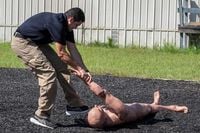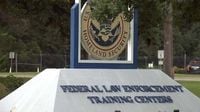On a sweltering August morning in Brunswick, Georgia, the Federal Law Enforcement Training Center (FLETC) bustles with a new urgency. Recruits for U.S. Immigration and Customs Enforcement (ICE) are sweating through obstacle courses, wrestling heavy dummies into handcuffs, and practicing how to haul a wounded partner out of harm’s way. The humid air is thick with the sound of shouted commands and the crack of gunfire from the sprawling indoor range, where shell casings scatter across the floor like confetti. It’s all part of a dramatic ramp-up in ICE training, fueled by an unprecedented influx of funding and a political mandate to expand the agency’s reach.
According to The Associated Press, this summer Congress approved a staggering $76.5 billion in new money for ICE—nearly ten times its annual budget. Of that, almost $30 billion is earmarked just for new staff. The goal? To bring on board 10,000 new deportation officers by the end of 2025, a massive leap from the current 6,500. This hiring surge is central to President Donald Trump’s renewed push for mass deportations, a policy that’s placed ICE at the very heart of the nation’s immigration debate.
But what does it actually look like to prepare so many new officers for such a daunting task? On August 21, 2025, journalists from The Associated Press and other outlets were given a rare glimpse inside the FLETC, the epicenter of federal law enforcement training. Here, ICE recruits—many just weeks into their law enforcement careers—are immersed in a boot camp that’s as much about legal nuance as it is about physical grit.
In one classroom, desks are cluttered with legal tomes: thick handbooks on immigration law, the Fourth Amendment, and the Immigration and Nationality Act of 1952. Recruits spend about 12 hours in these sessions, learning the intricacies of what makes a search or seizure constitutional, when they can enter a home, and under what circumstances someone can be removed from the country. ICE officials are quick to point out that immigration law is “second only to the tax code” in its complexity—a daunting prospect for any new officer.
Greg Hornsby, an associate legal adviser at ICE, explained the agency’s approach to enforcement. “Once local law enforcement makes a stop, and then they contact ICE saying we have somebody that we possibly think might be an alien, that’s where we step in,” he said. ICE staff emphasized that they do not conduct indiscriminate traffic stops or checkpoints; instead, they focus on targeted operations and require probable cause to act.
But the legal lessons are only one piece of the puzzle. The physical training is relentless. Six days a week, recruits live on the wooded grounds of the FLETC, just an hour north of the Florida state line and not far from the Atlantic coast. Hundreds have cycled through in recent months, each enduring roughly eight weeks of intensive instruction—though that’s just the beginning, as additional training comes both before and after the formal academy.
On the firing range, about 20 recruits—clad in blue shirts and pants—practice shooting from bent-elbow positions and work on transitional shooting, transferring their handguns from one hand to the other under the watchful eyes of instructors in red shirts. Everyone wears eye protection and double layers of hearing protection, underscoring the seriousness of the drills. Dean Wilson, who oversees firearms training, likened the uncertainty officers face in the field to a haunted house. “We do our very best to make sure that even though they’re in that environment, that they have the wherewithal to make the proper decision,” Wilson said. “Nobody wants to be the one to make a bad shot, and nobody wants to be the one that doesn’t make it home.”
Driving skills are another critical component. On a vast field dotted with specialized tracks, recruits learn to recover from skids on wet pavement and navigate tight, urban-style courses with blind corners and sudden stops. These drills are designed to mirror the unpredictable environments ICE officers may encounter during operations.
One controversial change to the curriculum is the elimination of five weeks of Spanish-language training. Caleb Vitello, assistant director of ICE in charge of training, explained that the language instruction had only brought recruits to a “moderately” competent level. Instead, the agency now relies on language translation technology in the field, a decision that has sparked some debate but, according to Vitello, allows for more focused training in other areas.
De-escalation is also a key focus. Acting ICE director Todd Lyons told reporters that the curriculum includes techniques designed to prevent the use of force whenever possible. “In any type of law enforcement situation, you’d rather de-escalate with words before you have to use any use of force,” Lyons said. This emphasis comes amid concerns that the rapid expansion of the agency could lead to shortcuts in vetting or training—a problem that plagued the Border Patrol during its own hiring surge in the early 2000s, when a spike in employee misconduct followed lowered standards.
Lyons, however, was adamant that ICE would not repeat those mistakes. “I wasn’t going to water down training,” he insisted, though he acknowledged that some processes have been streamlined to accommodate the surge. The focus, according to Lyons and Vitello, remains on producing well-prepared officers who understand both the physical and legal demands of the job.
Despite these assurances, some critics remain wary. The sheer scale and speed of the hiring effort—driven by political urgency and massive new funding—has raised questions about whether the agency can maintain high standards. ICE’s leadership, for its part, is betting that the combination of rigorous field exercises, updated technology, and legal education will be enough to meet the challenge.
As the sun beats down on the training grounds in Brunswick, the next generation of ICE officers is being forged—one obstacle course, legal briefing, and live-fire drill at a time. The stakes are high, and the scrutiny is intense, but the agency’s leaders insist they’re up to the task. For now, the only certainty is that ICE’s role in America’s immigration system has never been more visible—or more hotly debated.
With thousands of new officers soon to join their ranks, ICE is at a crossroads, balancing the demands of enforcement with the complexities of law and the realities of rapid institutional growth. The outcome of this transformation will shape the agency—and the broader immigration debate—for years to come.

